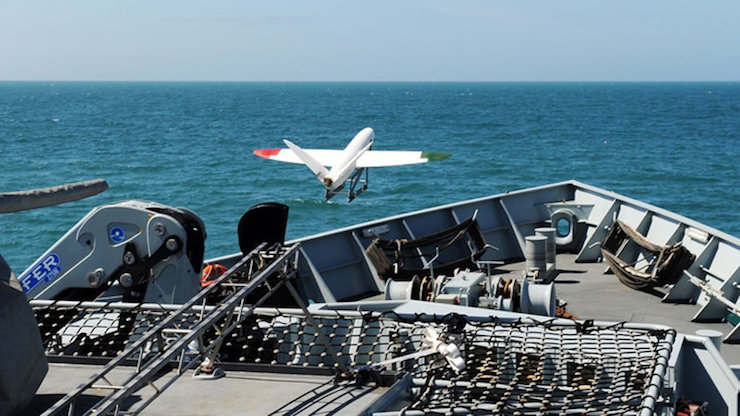Southampton University Builds 3D Printed Drones for the Royal Navy

For many industries investing in drone technology, one of the biggest draws to them is the fact that drones are relatively inexpensive to build and operate. So when someone finds a way to build drones at an even lesser cost, people take notice. In 2011, Southampton University in England built the first ever drone using a 3D printer at a fraction of the cost of standard drone designs.
Southampton University was established in 1862 as the Hartley Institution, a branch of the University of London. On April 29, 1952 it gained university status by royal charter and became officially known as Southampton University. Since then it has become one of the top 100 universities world wide. It is perhaps best known for it’s leading engineering programs. In 2010 it was ranked number one in the UK for Mechanical Engineering, Aeronautical Engineering, Naval Architecture, Electronic and Electrical Engineering. In 2011 Professors Andy Keane and Jim Scanlan from the University’s Computational Engineering and Design Research group led a project known as SULSA (Southampton University Laser Sintered Aircraft) to create the world’s fist printed air craft.
The design of the UAV was based off of Barnes Wallis’s Geodetic structure famously used on the 1936 Vickers Wellington bomber planes. This design uses a Spitfire, or an elliptical wing to enhance flight ability. As Professor Scanlan pointed out, “This form of structure is very stiff and lightweight, but very complex. If it was manufactured conventionally it would require a large number of individually tailored parts that would have to be bonded or fastened at great expense.” However, with the SULSA UAV everything from the wings, hatches, body, and integral control surfaces was built entirely with an EOS EOSINT P730 nylon laser sintering machine. Developed by Dr. Carl Deckard at the University of Texas at Austin, laser sintering is the process of compacting metal or plastic powder (as in this case) with heat or pressure into a solid form without it first melting into a liquid state. Using this process allows for the very rapid and inexpensive production of materials.
With laser sintering, the team was able to build a complex aircraft from it’s initial conception to it’s first flight in a matter of days rather than months. And though the printer itself is an expensive piece of equipment, the cost of building the UAV was minuscule compared to the costly means of traditionally building an aircraft. The entire aircraft is a snap and go UAV, meaning no tools are needed to put the pieces together. They just snap in place and are ready to fly. With a 2 meter wingspan the electric UAV has a top speed of 100mph and is virtually silent. It is equipped with an autopilot system developed by Dr. Matt Bennett which allows it to autonomously fly predetermined courses.
Professor Scanlan went on to say, “The flexibility of the laser sintering process allows the design team to re-visit historical techniques and ideas that would have been prohibitively expensive using conventional manufacturing.” While Professor Keane further explained, “Another design benefit that laser sintering provides is the use of an elliptical wing platform. Aerodynamicists have, for decades, known that elliptical wings offer drag benefits. The Spitfire wing was recognized as an extremely efficient design but it was notoriously difficult and expensive to manufacture. Again laser sintering removes the manufacturing constraint associated with shape complexity and in the SULSA aircraft there is no cost penalty in using an elliptical shape.”
While this program was especially exciting for the professors and students at Southampton University, it also caught the attention of the British Royal Navy. In July of 2015 Professor Scanlan boarded The HMS Mersey, a river class patrol vessel with a SULSA UAV he had assembled on land. He launched the drone for a 2 minute test flight from the deck of the Mersey using a 3 meter long catapult. He said, “The navy thinks today’s ship-launched UAVs are too expensive. Whoever is operating it is always petrified they might lose one.
The drones being used by the Navy for day to day activities can cost millions of dollars each. Though they are very accurate and advanced pieces of equipment, their costs often out weigh their benefits. With SULSA that worry is taken away as they cost only a few thousand dollars and are essentially disposable drones. If one gets lost at sea it is easily and inexpensively replaceable. Though these drones do not have as long as a flight time as the more advanced drones, they are perfect for day to day missions like localized surveillance. Needless to say the Royal Navy was impressed with the results of the test. As Kevin Franks, the deputy maritime account manager at the Defense Science and Technology Laboratory said, “The ability to use additive manufacture to make a task-specific tool, component, device or even a vehicle out in the field or in a space-constrained moving ship, could have significant impact on the armed forces’ shape and capability.”
|